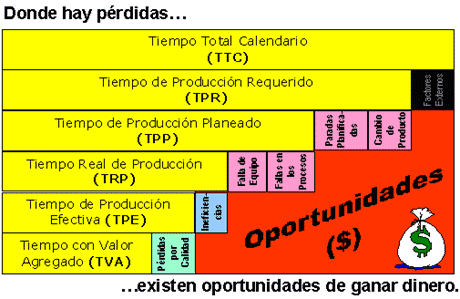There are numerous signals reaching us from all sectors: factories are reaching maximum production capacity, and at the same time, many sectors are fortunately continuing to see growing sales.
This reality leads many to propose the seemingly most logical alternative: we need to invest in more capacity. But is this the only solution? We believe not.
Generally, when calculating installed capacity, companies fail to consider what is now known as losses, that is, those opportunities for improvement that every industrial environment presents, but whose elimination requires reforms in current management paradigms. We are too accustomed to viewing the company in a single way, so it is difficult, if not impossible, to figure out how to make better use of existing resources. The losses are there, but we cannot see them.
Years ago, the Japanese Institute of Plant Maintenance (JIPM) identified what it called the 16 Great Industrial Losses. When eliminated, these losses open up incredible potential for improvement, which is revealed by combating losses in the production system. The consequences are extraordinary: in companies, there is a hidden treasure, another hidden factory that isn't producing.
While this isn't the place to describe them, let's say they can be divided into two broad categories: those associated with people, for example, management issues, skills issues, work methodologies, etc.; and losses associated with the equipment itself. These include, among others: failures due to breakdowns, time lost during tool changes and adjustments; idle time, minor downtime, and speed reduction.
For example, a machine initially designed to operate at 1,000 units/h has been operating at 850 units/h for years, and that has become "normal." This entails at least two losses: one associated with the people, who are no longer able to view this situation as abnormal. The other is associated with the equipment itself, which must be restored to its basic condition, that is, back to operating at 1,000 units/h.
Organizations are accustomed to facing problems, but there isn't enough action to address the root causes of those problems. Often, palliative solutions are found that alleviate the symptoms, but the root of the problem persists. It often happens that we're in too much of a hurry to stop for gas! It sounds foolish. But that's how we act.
As a result of ignoring these losses, companies are gradually developing idle capacity, which is more valuable than ever. Conversely, if companies embark on a campaign to eliminate losses, this means they can double their production with the same equipment and the same operators without acquiring new machines.
The key to current management systems such as TPM or Lean Manufacturing is the willingness to look deeply into the underlying issues and resolve them by eliminating their root causes. This is the key to their success.
Working to restore basic conditions by eliminating losses results in a real increase in production capacity that is often overlooked in calculations and is always "cheaper" than investing in new machinery. It has the advantage of dramatically increasing current production while simultaneously acquiring management technologies with incalculable returns on investment.
Of course, we must first accept that there are hidden and enormous losses in the company. Then, we must eliminate them, without investing in new equipment, but by fundamentally changing the way we view and understand our own organizations.

(Note published in Punto a Punto magazine on February 15, 2006)
